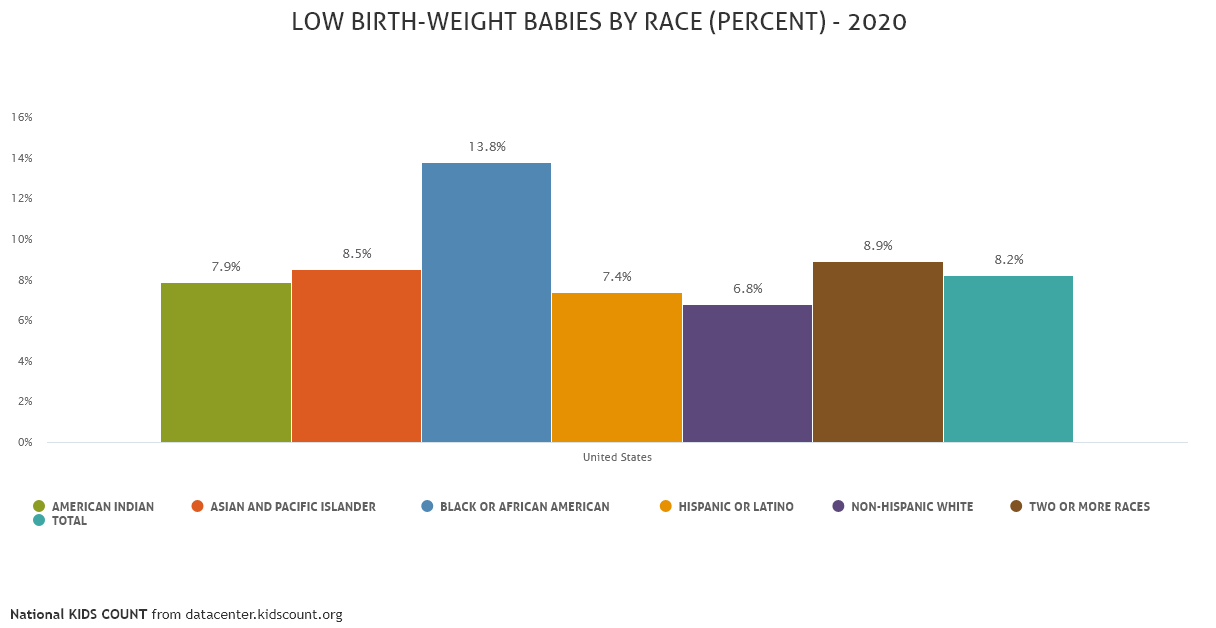Progress Largely Stalled on Preterm Births and Babies Born With a Low Birth Weight

Major progress to reduce the percentage of U.S. babies born prematurely or with a low birth weight has not occurred in decades, and racial inequities remain a serious public health concern.
What Is the Significance of Preterm Birth and Low Birth Weight?
Preterm birth (before 37 completed weeks of gestation) and low birth weight (less than 5.5 pounds) are leading causes of infant mortality in the U.S., and these babies are at higher risk of long-term health and developmental problems. Many factors can increase the likelihood of a baby being born prematurely or at a low birth weight, such as maternal smoking or substance use issues, low socioeconomic status, inadequate prenatal care, short spacing between births, experiences of racism, violence or abuse, environmental exposures, previous pregnancy complications, carrying more than one baby, being overweight or underweight, living in rural areas and more. Additionally, research has long shown inequities by race and ethnicity for preterm birth and low birth weight, particularly for Black infants.
What Are the Latest Preterm Birth and Low Birth Weight Findings?
According to new data in the KIDS COUNT® Data Center, the percentage of U.S. infants born preterm has not changed in recent years, holding steady at 12% from 2017 to 2020. In fact, this figure has hovered in the 11% to 13% range since 1990. Reducing preterm births has been a public health priority for many years, and the federal government is currently pursuing this priority as part of its Healthy People 2030 Objectives.
The percentage of U.S. babies born with a low birth weight declined slightly to 8.2% in 2020, after stagnating at 8.3% the previous three years. This figure has fluctuated between 8% and 8.3% since 2004, prior to which it had been rising for more than a decade, from 7% in 1990 to 7.9% in 2003. The percentage of very low birth-weight infants (less than 3.4 pounds) also inched down slightly in 2020, to 1.3%, after holding at 1.4% for 10 years.
Racial Inequities Remain an Urgent Concern
Despite growing research, advocacy, and public health efforts, Black mothers and babies continue to be at highest risk of adverse birth outcomes. The KIDS COUNT Data Center provides data on low birth-weight infants by race and ethnicity, illustrating these ongoing inequities, with 13.8% of Black newborns at a low birth weight in 2020, more than twice the percentage for white babies (6.8%). Figures for other infants of color are also higher than those of white infants: 8.9% for newborns with two or more races, 8.5% for Asians and Pacific Islanders, 7.9% for American Indians and 7.4% for Latinos. The national average falls in between these groups at 8.2%.

Low Birth Weight and Preterm Births Vary by Geography
Consistent with research on social determinants of health, geography and birth outcomes are strongly correlated. According to the KIDS COUNT Data Center’s preterm birth and low birth weight data by state, Mississippi, Louisiana and Alabama consistently have had the highest percentages of both preterm births and low birth-weight babies over the past decade. For instance, in 2020, 11.8% of Mississippi babies were born with a low birth weight and 17% were born premature, while 10.9% of Louisiana infants had a low birth weight and 18% were preterm, followed by Alabama with 10.8% and 15%, respectively. On the other end of the spectrum, Oregon had the lowest percentages for both measures in 2020, with 6.5% low birth-weight babies and 9% premature births.
The KIDS COUNT Data Center also offers data by territory and city. Puerto Rico has improved both of these birth outcomes over the last decade, although its percentages continue to be fairly high, with 10.2% of infants born at a low birth weight and 14% born prematurely in 2020. Among U.S. cities with data for both measures in 2020, Detroit, Milwaukee, Memphis and Baltimore had the highest percentages of low birth-weight babies and preterm births. Detroit and Memphis have ranked in the top five cities with the highest percentages for both measures since 2015.
Action to Reduce Preterm Births and Low Birth Weight
More can be done across multiple sectors to prevent preterm births and low birth weight and to eliminate inequities. Examples of strategies:
- Promote the health of reproductive age individuals before, during and after pregnancy, including helping women to quit smoking
- Improve access to timely, culturally appropriate prenatal care, especially for women of color and those in low-income and rural communities
- Encourage spacing pregnancies apart by at least 18 months
- Address social determinants of health, including structural racism and systemic barriers to high-quality health care
Access More Birth Data in the KIDS COUNT Data Center
See additional indicators on births and birth outcomes, such as:
- Births to women receiving late or no prenatal care, by race and ethnicity
- Births to mothers who smoked during pregnancy
- Births to mothers with less than 12 years of education
- Teen births by age group, by race and ethnicity
- Infant mortality, by race and ethnicity
The Data Center’s low birth weight indicator is also included in the Foundation’s Race for Results® series and in the KIDS COUNT Child Well-Being Index, as part of the KIDS COUNT Data Book.
Stay Connected with the Data Center
Sign up for our newsletters to get the latest data, reports and other resources.





